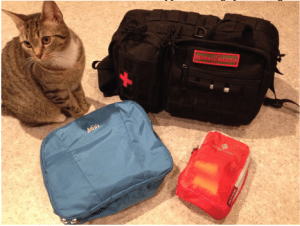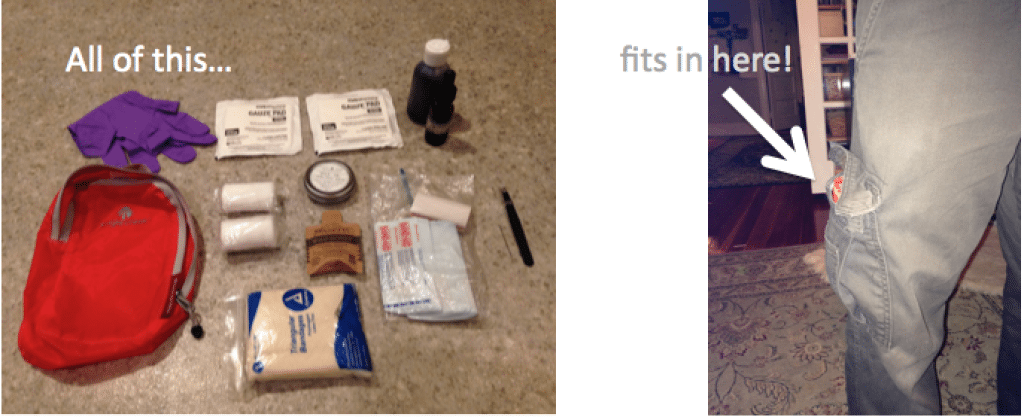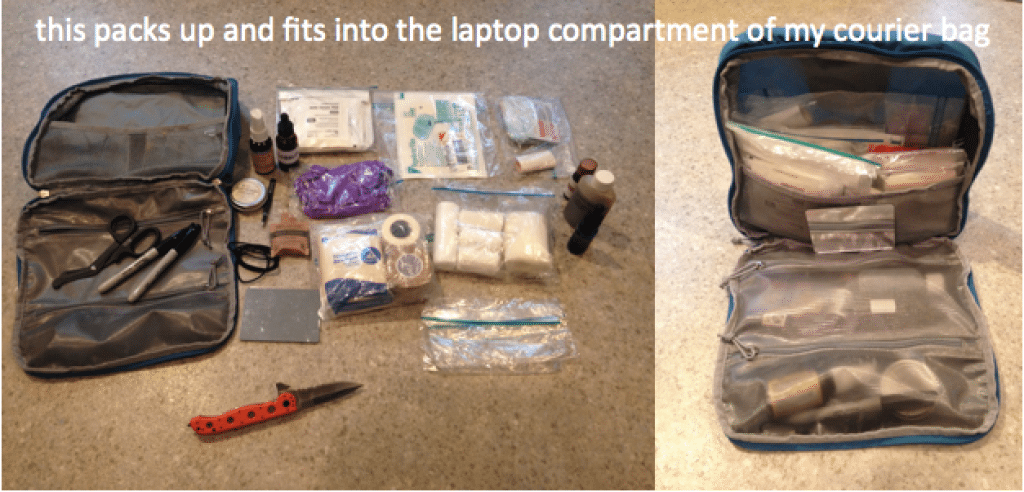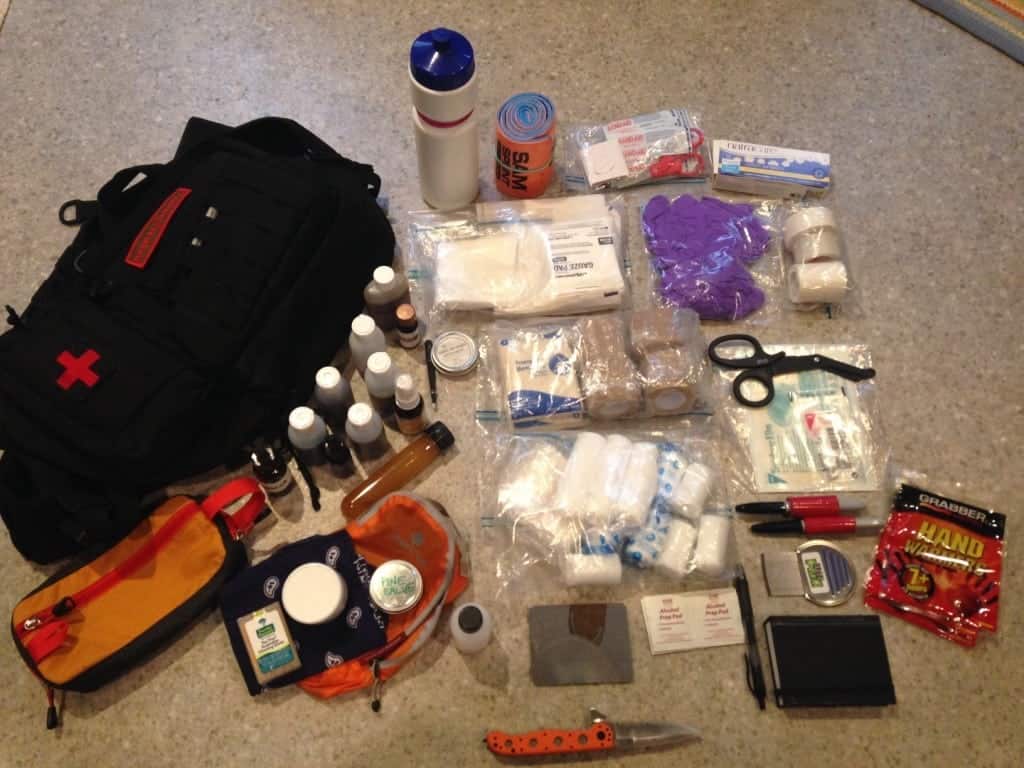First Aid Kits For Everyone!
Why should you carry a first aid kit? Think about the places you go every day – the grocery store, a restaurant, the subway, a kids’ soccer game: if something happened, do you know where to find a first aid kit? If you did find one, would you know how to use it? Would it have what you need?

It doesn’t have to be a full-on disaster scenario to need a first aid kit: a reasonably minor subway accident, for example, will still have injuries. Anyone can step off the curb wrong and twist their ankle, or kids running around can scrape knees. If you carry your own kit, you always know that you have what you need!
Before you even start collecting items, recognize that skills are the very first thing that goes into your kit. Learning how to respond to the things happening around you, learning to bandage and splint, and learning to correctly clean and dress a wound are key skills that everyone should know – even kids!
Once you have those skills, it’s important to practice them regularly so that you keep everything fresh, and so that you even develop muscle memory when it comes to wrapping, splinting, and bandaging. This could be a weekly or monthly family fun event – kids really love learning these skills, and they’re perfectly happy to let you wrap them up like mummies so that you can practice too! Finally, practicing these skills in a calm environment will help you stay calm if you need to use them in a real emergency. Likewise, allowing someone to practice on you while you relax calmly will help you remain calm if you are ever injured.
What should you carry?
What you carry depends on where you are, and what you and other people will be doing there. Think about the places you go every day: what
environment are you in? What kind of people are there? What sorts of activities are going on? How accessible is conventional medical care?
For example, you might be going to a baseball game where you’re not allowed to carry a backpack. You know there’s likely to be conventional medical care right on site, so there’s no need to carry a big kit, and you’re not allowed a backpack anyway. A small pouch that fits in a cargo pocket would be appropriate for this situation.
You should also consider what kind of training you have: what sort of injuries do you feel comfortable working with? What sort of tools do you feel comfortable working with? If you don’t have training to splint breaks or sprains, for example, then you probably don’t need to take up space in your kit with a SAM Splint. It’s better to have a smaller kit of things you know how to use well than a large kit of things you aren’t familiar with!
How will you carry it all?
When you’re thinking about a bag to carry your stuff in, consider the following:
- Comfort – can you wear/carry it all day? What if you have to carry or assist another person?
- Size – will it hold what you need without being too large or heavy to manage?
- Ease to work in – perhaps you want a bag that can unzip and lay flat so that you can easily lay it down on the ground to work. Or you may prefer a bag that you can comfortably open while you’re still wearing it. Whatever you choose, make sure that it’s easy to root around in and find what you need.
- Water/weather proof – it’s important that your stuff will stay dry if you’re working in the rain or snow.
- Appropriate appearance – you might want to stand out as a medic, so that people who need you can find you easily. However, there are some times that you don’t want to draw attention to yourself. You might consider velcro if you’re going to use patches, so that you can quickly remove them if necessary.
Keep in mind that bags sold as first aid kits may not be the bag that best suits your needs. Pre-filled first aid kits are also generally not to my liking, as they contain a lot of items I won’t use and not enough of the items I like to use most. When you build your own, you know that you’re carrying supplies that you’re trained to use, that you can use effectively and efficiently, and you’re not carrying a bunch of extra weight for things that you won’t use. One exception would be the fantastic Herbal Medic First Aid Kits that Sam Coffman makes – we have one of his and we love it.
Inside your bag, pack things in Ziploc bags to keep them weather proof when the bag is open. I like to use Ziploc to organize too – roller gauze in one Ziploc, bandaids in another. Always carry some extra Ziplocs for unexpected things, biohazard trash containment, etc.
We use HDPE and Nalgene plastic bottles to store herbal preparations in: in tests done by various herbalists and herbal products companies, it seems that chemicals don’t leech into tinctures from these two types of plastic, and they are much lighter weight and they don’t break. If you prefer to pack glass, make sure to wrap your glass in cloth so that there’s less likelihood of breakage, and keep them in separate waterproof bags so that if they do break, you don’t have tincture spilled on your gear.
Use your kit!
Once you’ve got your kit packed and ready, don’t squirrel it away – use it!
Even if you still keep some bandaids and first aid supplies in the bathroom cupboard, get in the habit of going for your kit every single time you have an injury to deal with. This way you’ll get comfortable working with it – and it gives you a chance to discover things that are missing before you’re in an emergency situation!
What’s Inside?
I have three different kits ready to go whenever I need them. They are my Tiny Carry kit, which fits in a cargo pocket, my Daily Carry kit, which fits in the laptop sleeve of my courier bag, and my Street Kit, which is a big enough kit for working for a day with a homeless community, working at a protest, or to grab quick for an evacuation. You will likely have more than one kit as well, based on the types of things you do regularly.
Tiny Carry
This kit is small enough to fit into a cargo pocket, useful in situations where you don’t want to have a lot of weight, or where you can’t actually carry anything except what’s on your body.

BANDAGES and GEAR
1 triangle bandage
2 2″ roller gauze
2 3×3 gauze pads
a handful of 1″ bandaids
and a pair of gloves
tweezers & a needle
Additionally, I carry my knife in another pocket
HERBS
Pine resin salve (Pine resin, Plantain oil, beeswax)
abrasions, light lacerations, boils, etc
Wound wash: Thayer’s brand Rose water Witch Hazel extract or a tincture that is some combination of Usnea/Loosestrife/Propolis/Yarrow/Coptis and water.
washing wounds, dental abscesses, anti-septic.
additionally, Thayer’s is useful for a burn.
Manuka honey packets
burns, wounds, abrasions
Lobelia tincture
anaphylaxis, asthma attacks, muscle relaxant
Daily Carry
This kit is small enough to fit into the backpack or bag you carry every day, useful in everyday situations in your everyday environment.

BANDAGES and GEAR
2 triangle bandage
3 2″ roller gauze , 2 4” roller gauze
10 assorted size gauze pads
1 self-occlusive bandage
roll of paper tape
2 Tegaderm 4×4.75”
3 Steri-Strips
a handful of 1″ bandaids
5 pair nitrile gloves
Narcan for opiate overdose (not pictured)
alcohol swabs (for cleaning tools, not wounds)
trauma shears, tweezers & a needle
sharpie, extra ziplocs,
ponytail holders ,plastic mirror
handwarmers
Additionally, I carry my knife in another pocket
HERBS
Pine resin salve (Pine resin, Plantain oil, beeswax)
abrasions, light lacerations, boils, etc
Wound wash: Thayer’s brand Rose water Witch Hazel extract or a tincture that is some combination of Usnea/Loosestrife/Propolis/Yarrow/Coptis and water.
washing wounds, dental abscesses, anti-septic.
additionally, Thayer’s is useful for a burn.
Manuka honey packets
burns, wounds, abrasions
Lobelia tincture
anaphylaxis, asthma attacks, muscle relaxant
Lavender essential oil
muscle relaxant, nervous system relaxant, burns, antiseptic. essential oils should be diluted.
Chamomile tincture
cramping, indigestion, panic attack, fever
Ghost Pipe/Solomon’s Seal/Sage tincture
panic attacks, rage, anxiety, physical pain
Street Kit / Long Trip Carry
This is a big kit that is suitable for working in the street with homeless people, during protests/riots, in a natural disaster, or for taking on a long trip or evacuation. You’re going to carry this kit for a long time, possibly while you’re carrying an injured person: make sure it’s not too heavy!

BANDAGES and GEAR
3 triangle bandages
10 2″ roller gauze, 8 4” roller gauze
25 assorted gauze pads
4 self-occlusive bandage
rolls of paper, cloth, and traspore tape
5 Tegaderm 4×4.75”
6 Steri-Strips
1″ bandaids, moleskin
10 pair nitrile gloves
SAM splint
Narcan for opiate overdose (not pictured)
alcohol swabs (for cleaning tools, not wounds)
tweezers & a needle, steel lice comb, extra safety pins
shears, sharpies, tick remover, ponytail holders,
tea tree toothpicks, menstrual items, plastic mirror, space
blanket/trashbag, handwarmers
EMT knife with seatbelt cutter and window breaking end
notepad
PERSONAL GEAR
Things for sustaining myself that I won’t share with other people. This is because it’s important that as medics, we sustain ourselves, so that we can stay strong and keep working. We’re no good to anyone if we get hurt. For me, this usually includes snacks, bandana, hygene items, maps, chapstick, my own herbal items, cash, extra clothing, etc.
HERBS
Pine resin salve (Pine resin, Plantain oil, beeswax)
abrasions, light lacerations, boils, etc
Wound wash: Thayer’s brand Rose water Witch Hazel extract or a tincture that is some combination of Usnea/Loosestrife/Propolis/Yarrow/Coptis and water.
washing wounds, dental abscesses, anti-septic.
additionally, Thayer’s is useful for a burn.
Manuka honey packets
burns, wounds, abrasions
Lobelia tincture
anaphylaxis, asthma attacks, muscle relaxant
Lavender essential oil
muscle relaxant, nervous system relaxant, burns, antiseptic. essential oils should be diluted.
Chamomile tincture
cramping, indigestion, panic attack, fever
Ghost Pipe/Solomon’s Seal/Sage tincture
panic attacks, rage, anxiety, physical pain
Wood Betony (Stachys off)
concussion, panic, gi upset, dissociation
Ginger tincture
nausea, GI upset, anti-spasmodic
Gold Thread (Coptis trifolia) tincture
anti septic, anti microbial, berberine content. Coptis is abundant where I live and I can harvest it sustainably; use whatever berberine containing plant is abundant where you live, such as Oregon Grape root, Barberry root, or organically farmed Goldseal.
bentonite clay
food poisoning, stings, weepy skin conditions
shea butter
chilblains, cold tolerance, chapping, peeling skin, sunburns and dry damaged skin
Cayenne powder
cardiac arrest, vital force stimulant
Cinnamon powder
athlete’s foot, trench foot, GI upset, cough, antispasmodic
Want more information?
This article was last updated in June 2024.
It originated as a webinar with Katja Swift and Sam Coffman in 2015. You can watch the webinar for free here: Creating and Using your own Herbal First Aid Kit.
For a deep dive into emergency & post-disaster herbalism, check out our Emergent Responder courses:
3 Comments
Leave a Comment
You must be logged in to post a comment.

Join our newsletter for more herby goodness!
Get our newsletter delivered right to your inbox. You'll be first to hear about free mini-courses, podcast episodes, and other goodies about holistic herbalism.

[…] Why should you carry a first aid kit? Think about the places you go every day – the grocery store, a restaurant, the subway, a kids' soccer game: if something happened, do you know where to find a first aid kit? If you did find … Article by first aid kits – Google Blog Search. Read entire story here. […]
[…] First Aid Kits For Everyone! – including our “tiny carry”, every day carry, & street kit breakdowns. […]
[…] – but you probably want to pack a few more things. Here’s a blog post about how to make your own herbal first aid kit! And if you’re thinking about emotional first aid, check out our podcast episode on the […]